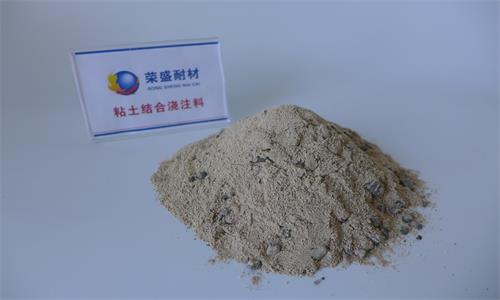Fire Clay Refractory Castable has the characteristics of high medium temperature strength, high thermal strength, good volume stability at high temperature and strong drop resistance. Rogngsheng refractory material factory can provide high quality and competitive price refractory castable and perfect after-sales service , what’s more, RongSheng Group have profession sales team and technology team & technology continuous tracking, welcome to inquiry, Rongsheng refractory factory can provide free quote!
Fire Clay Refractory Castable Introduction
Clay Refractory Castable is a castable refractory material prepared by using soft clay as a binder and refractory aggregates, powders and admixtures such as aluminum silicate or corundum mullite. The composition of the clay castables is generally 55% to 65% for refractory aggregates, 20% to 30% for refractory powders, and 10% to 15% for combined (soft) clays. The maximum allowable particle size of refractory aggregate is 8mm, and the aggregate size of aggregate is 8~5mm, 35%~40%; 5~3mm, 30%~35%; <3mm, 25%~30%. The particle size requirement of the refractory powder is less than 0.074 mm and accounts for more than 90%. The combined clay particle size should be less than 0.074mm and account for over 95%
Fire Clay Refractory Castable Feature
1.Refractory castable clay have good thermal exfoliation.
2.Fire clay refractory castables have good resistance to slag invasion.
3.Refractory casable fire clay have high refractoriness, up to 1550 ℃ ± 50 ℃.
4.Refractory fire clay castable have good plasticity and convenient construction.
5.Castable fire clay refractory have strong bonding strength and strong corrosion resistance.
Fire Clay Refractory Castable Specification
Chemical Composition
(%) |
Al2o3% |
75 |
85 |
95 |
| Sio2% |
20 |
10 |
2 |
| Cao% |
2.5 |
1.5 |
1.2 |
| Bulk Density (g/cm3) |
110℃*24h |
2.75 |
2.85 |
2.95 |
| 815℃*3h |
2.75 |
2.85 |
2.95 |
| 1100℃*3h |
2.80 |
2.90 |
3.10 |
| Cold Crushing Strength(Mpa) |
110℃*24h |
60 |
140 |
140 |
| 815℃*3h |
65 |
145 |
135 |
| 1100℃*3h |
70 |
150 |
130 |
| Flexural strength(Mpa) |
110℃*24h |
8 |
22 |
22 |
| 815℃*3h |
9 |
21 |
18 |
| 1100℃*3h |
12 |
20 |
18 |
| The amouct of room temperature wear(cm3) |
|
8 |
4.5 |
6 |
Fire Clay Refractory Castable Application
Refractory fire castable suitable in cyclone, returner, burner, mixing chamber top of furnace.
Fire Clay Refractory Castable Manufacturing Process
Clay refractory castable production process: refractory material selection - ingredients - mixing - packaging - storage
1. Refractory material selection is a very important process. Refractory material is an important part to ensure the preparation of clay castables refractory. According to the formula and application, suitable refractory clay castable aggregates, powders, binders and additives are selected.
2. The ingredients are according to the formula, the selected refractory raw materials are screened according to the grade, and the particle size of the aggregate and the powder are strictly controlled.
3. When stirring, first stir the powder evenly, then stir the aggregate evenly. The stirred powder is added to the aggregate and mixed and stirred to control the stirring time. The time should not be too short, generally 8-10 minutes.
4. Put the stirred clay castable refractory into the ton bag, equip it with additives and binders, then package.
5.Packaged refractory castables are placed in the warehouse for storage, date identification and moisture-proof waterproof treatment.
Refractory Clay Castables Use Precautions
1.Pay attention to vibration time and vibration mode during construction.
2.When making refractory clay castable mud on site, strictly control the water consumption.
3.Control the baking process after pouring, prohibiting excessive temperature rise to prevent cracking of the construction body.


